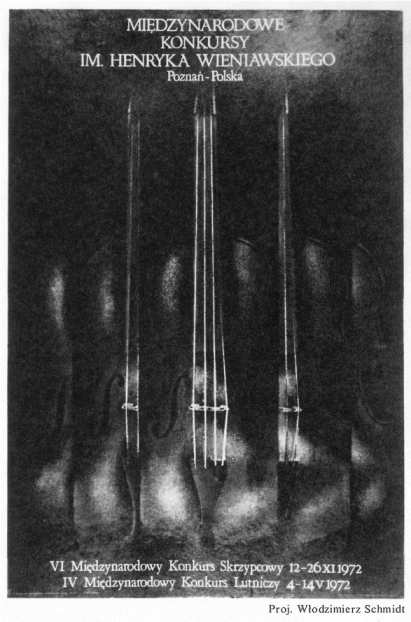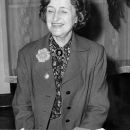6th International Henryk Wieniawski Violin Competition
Poznań, 12-26 November 1972
Watch a documentary about the competition:
Canditates had already started coming to Poznań. This time also from faraway places. The first Japanese in the history of the Wieniawski Competition, Machie Oguri, was greeted with flowers. The town was adorned with special decorations, colourful posters, and national flags of competition participants. One could already feel the atmosphere of the upcoming event. Meanwhile, just one day before the opening of the competition, the University auditorium was still… a building site; apparently, the decision to bring it back to its former glory and, at the same time, adjust it to the requirements of the present day (incl. extension of the stage, redecoration, and exchange of the seating) was simply taken too late. However, to the disappointment of “well-wishers”, no scandal followed. The opening ceremony of the 6th Competition went according to a meticulously elaborated plan, and elegant perfume of the invited ladies would soon quench the smell of fresh paint on the walls.
It was truly a ladies’ competition. Three of them took the entire medal podium. On its highest step stood Tatiana Grindenko from Kharkov. Assistant to Prof. Yankielevich at the Moscow Conservatory, Gidon Kremer’s wife. Self-confident, commanding attention with extraordinary talent and good looks, she would refuse — albeit with apologetic smile — even a single word to journalists. It was only on Sunday, 26 November, at 2:35 a.m., when her well-deserved success was announced, that she was ready to talk about it: extensively, beautifully and wisely. When asked how long it had taken her to prepare for the competition, she said, “If I replied ‘all my life’, it wouldn’t be much of an exaggeration. Had I started the moment I received the invitation, I wouldn’t have done much...”
It was the Japanese Shizuka Ishikawa, a violin player of “heavenly sound”, as she was labelled by a critic, who rejoiced in the Second Prize and Silver Medal; among other things, she found recognition with the most beautiful interpretation of Szymanowski’s myth Driady i Pan. Her name opens the very long list of the event’s Japanese laureates. And finally, the bronze laurel, the 19-year-old Pole, Barbara Górzyńska, a first-year student from Łódź: with a virtuoso verve, exceptionally musical, sensitive, lyrical, a talent of immense potential...
However, the first and most prominent Lady of the Competition was Prof. Irena Dubiska. She sat on the jury of all post-war editions of the contest. Her students were successful in all editions of the competition (including the 1935 event). Now she debuted as the Chairwoman of the jury. When necessary, she could celebrate the dignity of her rank, only to be herself again the next moment. Of petite physique and great personality, a renowned artist and yet a very straightforward person, she liked to tell stories, most gladly about the good old days, about her masters Karl Flesch and Bronisław Huberman, about her own career which she began on reputed stages where she would turn scores for outstanding pianists.
A press reporter from Warsaw closed his final account with suspicion of a feminist conspiracy: “This year’s chairmanship of the jury in the hands of a woman”, he wrote, “and the body featuring yet another key female violin player of ours [...], leads one to think about a possible plot of the fairer sex against this sterner. This, naturally, is a joke. There was no such conspiracy in the jury; Grindienko, Ishikawa and Górzyńska simply turned out to be the most talented competitors [...]. What the event’s participants and observers saw in Poznań, in turn, were the qualities typically attributed to the town: efficient organisation and sensitive audience, which filled to capacity the beautifully renovated University auditorium. Luckily, its famous acoustics remained unspoilt in the renovation”.
source: R. Połczyński, Da Capo. 75 lat Międzynarodowych Konkursów im. Henryka Wieniawskiego
Read more about the 6th Competition (PDF, 604 KB) >

A poster of 6th edition of Wieniawski Violin Competition designed by W. Schmidt.
JURY MEMBERS
Chairman: Irena Dubiska (Poland)
Wladimir Awramow
(Bulgaria)
Zenon Brzewski (Poland)
Jean Fournier (France)
Tibor Gašparek (Czechoslovakia)
Bronisław Gimpel (USA
)
Frederick Grinke (Great Britain)
Anja
Ignatius (Finland)
Jadwiga Kaliszewska (Poland)
George Manoliu (Roumunia)
Wolfgang
Marschner (GFR)
Igor Oistrakh (USSR
)
Zenon Płoszaj (Poland)
Franz Samohyl (Austria)
Werner Scholz (GDR)
Mihaly Szücs (Hungary
)
Eugenia Umińska (Poland)
PRIZE WINNERS
1st prize:
Tatiana GRINDENKO (USSR)
2nd prize: Shizuka ISHIKAWA(Japan
)
3rd prize: Barbara
GÓRZYŃSKA (Poland)
5th prize: Tadeusz GADZINA
(Poland), Grachia
ARUTIUNIAN (USSR
)
6th prize: Stefan CZERMAK
(Poland)
7th prize: Edward Zbigniew
ZIENKOWSKI (Poland)
Awards: Stefan Stałanowski (Poland); Magda Sarbu (Roumunia); Machie Oguri (Japan)



















